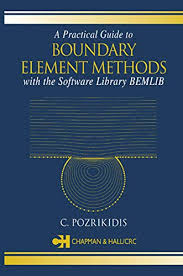“A Practical Guide to Boundary Element Methods with the Software Library BEMLIB” by A. Pozrikidis is a comprehensive resource that combines theory with practical implementation guidance for Boundary Element Methods (BEM). Published in 2002, this book provides a detailed introduction to the theory and application of BEM, a numerical technique widely used for solving partial differential equations in engineering and physics.
Pozrikidis begins by introducing the fundamental concepts and mathematical principles underlying boundary element methods. He covers topics such as integral equations, Green’s functions, and discretization techniques, providing readers with a solid theoretical foundation.
What sets this book apart is its focus on practical implementation. Pozrikidis introduces BEMLIB, a software library specifically designed to facilitate the implementation of boundary element methods. He provides step-by-step guidance on using BEMLIB to solve various types of boundary value problems, including Laplace, Helmholtz, and Stokes equations.
The book includes numerous examples and case studies, allowing readers to gain hands-on experience with implementing and solving boundary element problems using BEMLIB. Additionally, Pozrikidis provides insights into best practices, numerical techniques, and strategies for optimizing the performance and accuracy of boundary element simulations.
Overall, “A Practical Guide to Boundary Element Methods with the Software Library BEMLIB” serves as an invaluable resource for researchers, engineers, and students interested in learning and applying boundary element methods to solve real-world problems in fluid mechanics, solid mechanics, electromagnetics, and other fields. Its combination of theoretical exposition and practical implementation guidance makes it an essential reference for both beginners and experienced practitioners of boundary element methods.
